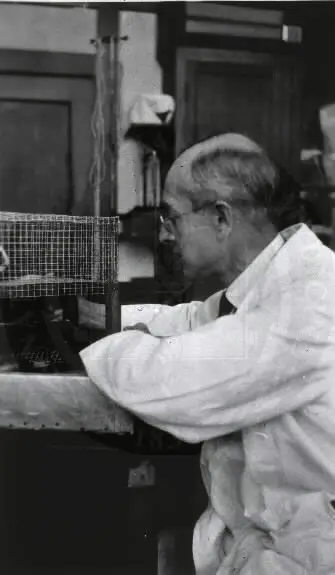 |
John AUER (1875-1948) John Auer belonged to the second generation of American immigrants. His father was a German brewer. He graduated B.S. from Michigan University in 1898 and graduated from Johns Hopkins Medical School in 1902, and was soon influenced by the well-known and inventive physiologist Samuel James Meltzer (1851-1920) at the Rockefeller Institute. Auer and Meltzer were to work together closely and intensely for 18 years. They were also close friends in their private life, with ample opportunities to confront each other with new ideas. As early as in 1903 Meltzer also became Auer's father-in-law. Meltzer's daughter Clare, who became Auer's wife, worked in the same laboratory. Together Meltzer and Auer published more than 25 works. Perhaps Meltzer was the man with the ideas, with Auer the skilful experimenter. Auer was appointed associate pharmacologist of the Rockefeller Institute in 1907, associate member in 1908. After the death of his father-in-law Auer moved to St. Louis, where he became professor of pharmacology and director of a department of St. Louis University School of medicine, from 1924 also pharmacologist at the St. Mary’s group of hospitals. While at the Rockefeller Institute with S. J. Meltzer, he investigated the effects of magnesium on tetany. The pioneer work on the intracellular rods that bear his name was commenced with a clinical case description. The patient was a young man, 21 years of age, then only 10 years younger than Auer, who had been admitted to the Johns Hopkins Hospital due to a nose bleeding and a throat infection. The patient was admitted to William Osler's service, when Auer was Osler’s house officer. His studies of anaphylaxis belong in the early history of immunology. He gave the first account of the physiological events associated with anaphylaxis in the guinea pig, and these studies gave Meltzer the basic idea for his hypothesis that bronchial asthma is caused by hypersensitivity to foreign substances, something not theretofore known. After moving to St. Louis, however, his experimental activity dwindled; in stead he concentrated his efforts more in teaching. He became a cherished mentor for new generations of students, and to them a living example that humanism is compatible with medical science. John Auer was described as a person with wide interests. He loved intellectual argumentation, and could be heavily engaged in debates. It was common for him to remain after lunch in order to discuss with younger colleagues. He often took an oppositional stand and advocated inopportune views. Auer took a great love in art, particularly Matisse, at a time when Matisse's greatness was still not recognized by the establishment. He considered himself an amateur painter. Saturdays he used to go for trips to sketch or paint, usually finishing with a visit to the local art museum. A well-rounded scholar he read French, German, and Latin authors - in the original language. He was also a keen gardener who liked to be called garden master. He died with a coronary thrombosis. His most important contribution maybe was not the Auer rods, but a method of ventilating the lungs with anaesthetic gas even without lung movements, e.g. during open thorax surgery. This method of intra-tracheal intubation to give «continuous respiration without respiratory movement» was used all over the world. It was described in Journal of Experimental Medicine, New York, 1909, 11: 622. |

